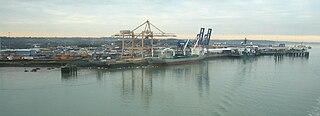
The great storm of 1703 was a destructive extratropical cyclone that struck central and southern England on 26 November 1703. High winds caused 2,000 chimney stacks to collapse in London and damaged the New Forest, which lost 4,000 oaks. Ships were blown hundreds of miles off-course, and over 1,000 sea men died on the Goodwin Sands alone. News bulletins of casualties and damage were sold all over England – a novelty at that time. The Church of England declared that the storm was God's vengeance for the sins of the nation. Daniel Defoe thought it was a divine punishment for poor performance against Catholic armies in the War of the Spanish Succession.


HMS Edinburgh was a Town-class light cruiser of the Royal Navy, which served during the Second World War. She was one of the last two Town class cruisers, which formed the Edinburgh sub-class. Edinburgh saw a great deal of combat service during the Second World War, especially in the North Sea and the Arctic Sea, where she was sunk by torpedoes in 1942.

HMS Erin was a dreadnought battleship of the Royal Navy, originally ordered by the Ottoman government from the British Vickers Company. The ship was to have been named Reşadiye when she entered service with the Ottoman Navy. The Reşadiye class was designed to be at least the equal of any other ship afloat or under construction. When the First World War began in August 1914, Reşadiye was nearly complete and was seized at the orders of Winston Churchill, the First Lord of the Admiralty, to keep her in British hands and prevent her from being used by Germany or German allies. There is no evidence that the seizure played any part in the Ottoman government declaring war on Britain and the Triple Entente.

Association was a 90-gun second-rate ship of the line of the Royal Navy, launched at Portsmouth Dockyard in 1697. She served with distinction at the capture of Gibraltar, and was lost in 1707 by grounding on the Isles of Scilly in the greatest maritime disaster of the age. The wreck is a Protected Wreck managed by Historic England.

The Racecourse-class minesweepers were 32 ships delivered to the Royal Navy during the First World War. They were built to two related designs as paddlewheel coastal minesweeping sloops under the Emergency War Programme. The vessels were reasonable sea-boats, but lost speed badly in a seaway when the paddle boxes tended to become choked with water. The class is also widely referred to as the Ascot class and Improved Ascot class.

HMS Badger was a shore establishment of the Royal Navy on the east coast of the United Kingdom. She was commissioned on 13 September 1939 was the flagship of the headquarters of the Flag Officer in Charge (FOIC), Harwich who was responsible to Commander-in-Chief, The Nore, and was decommissioned on 21 October 1946, although the Operations Room remained as the Emergency Port Control for the Harwich area. The site was Parkeston Quay, now Harwich International Port, and the bunker lies under Hamilton House, currently an occupational health centre, close to the entrance to Harwich International Port, a few miles west of Harwich.

HMS Princess Irene was a 5,394 GRT ocean liner which was built in 1914 by William Denny and Brothers Ltd, Dumbarton, Scotland for the Canadian Pacific Railway. She was requisitioned by the Royal Navy on completion and converted to an auxiliary minelayer. On 27 May 1915, she exploded and sank off Sheerness, Kent, while being loaded with mines prior to a deployment mission, with the loss of 352 lives.

HMS Regent was a Rainbow-class submarine designed and built by Vickers Shipbuilding and Engineering in Barrow-in-Furness for the Royal Navy, and was launched on 11 June 1930. She was lost with all hands after striking a mine on 18 April 1943.
PS Minerva was a 306 GRT passenger paddle steamer that J&G Thomson launched in 1893 for the Glasgow and South Western Railway (G&SWR). She served with the Royal Navy from 1916 and was sold into civilian service in Turkey in 1924. She was scrapped by 1928.
PS Glen Rosa was a 306 GRT passenger paddle steamer that J&G Thomson launched in 1893 for the Glasgow and South Western Railway (G&SWR). She served with the Royal Navy in the First World War as HMS Glencross. She was absorbed into the London, Midland and Scottish Railway fleet in 1923, transferred to the Caledonian Steam Packet Company in 1938 and scrapped in 1939.
PS Slieve Donard was a United Kingdom passenger paddle steamer that in different periods of her history was also called PS Albion and HMS Albyn. Albion is the name she bore the longest and may be the one by which she is better known in England. Slieve Donard was her original name and the one by which she will be best known on the island of Ireland.
PS Slieve Bearnagh was a United Kingdom passenger paddle steamer that in later years was called HC5. J&G Thomson launched her in 1893 or 1894 for the Belfast and County Down Railway (B&CDR). In 1912 she was sold to D&J Nicol of Dundee. Around the end of the First World War she served with the Royal Navy as hospital carrier ship HC5. She was scrapped in 1923.

SS Mona's Isle was a steam turbine passenger ship that was built in Scotland in 1905 as Onward, renamed Mona's Isle in 1920, and scrapped in Wales in 1948. She was designed as an English Channel ferry for the South Eastern and Chatham Railway (SE&CR), who operated her between Folkestone and Boulogne. In 1920 the Isle of Man Steam Packet Company (IoMSP) bought her and renamed her Mona's Isle. The IoMSP ran her mainly on summer services linking Douglas with Dublin and Belfast. She was the fourth IoMSP ship to be called Mona's Isle.
PS Duchess of Richmond was a passenger vessel built for the London and South Western Railway and London, Brighton and South Coast Railway in 1910.

PS Eagle III was a passenger-carrying paddle steamer that was built and sailed on the Clyde, and was twice requisitioned by the Admiralty to serve as a minesweeper during the world wars.
PS Gracie Fields built in 1936, was the last paddle steamer built for Red Funnel as a ferry and excursion steamer. She ran on the Southampton-Cowes route until the outbreak of World War II, when she was requisitioned and served as HMS Gracie Fields as a minesweeper. After successfully evacuating troops from the Dunkirk beaches, she was seriously damaged by an aircraft bomb on 29 May 1940, and sank the following morning.
Several vessels have been named Duchess of Buccleugh or Duchess of Buccleuch for one or another Duchess of Buccleuch:
Several vessels have been named Lune.











